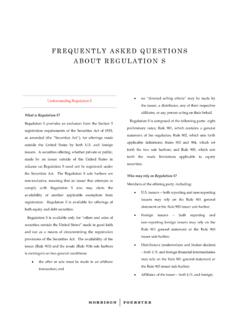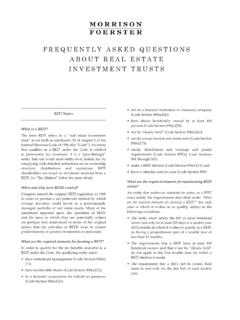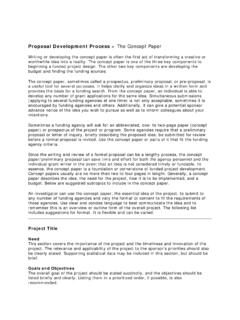Transcription of Frequently Asked Questions about Shelf Offerings
1 F R E Q U E N T L Y A S K E D Q U E S T I O N S A B O U T S H E L F O F F E R I N G S Understanding Shelf Offerings What is a Shelf registration statement? A Shelf registration statement is a filing with the Securities and Exchange Commission (the SEC ) to register a public offering, usually where there is no present intention to immediately sell all the securities being registered. A Shelf registration statement permits multiple Offerings based on the same registration. A Shelf registration can be used for sales of new securities by the issuer ( primary Offerings ), resales of outstanding securities ( secondary Offerings ) or a combination of both.
2 With an effective Shelf registration statement, when the issuer wants to offer securities, it takes them off the Shelf . These Shelf takedowns usually are made pursuant to a base prospectus and a prospectus supplement. See What is a base or a core prospectus ? and What is a prospectus supplement ? In a Shelf registration statement, securities usually are registered for sale either on a continuous or delayed basis, although a portion of the securities may be offered immediately. See What is the difference between a delayed and a continuous offering?
3 It should be noted that the rules described in these FAQs do not apply to registered investment companies and business development companies, which are regulated under the Investment Company Act of 1940, as amended. Source: Rule 415 of the Securities Act of 1933 (the Securities Act ) provides the basis for Shelf registration. What are the benefits of Shelf registration statements? An effective Shelf registration statement enables an issuer to access the capital markets quickly when needed or when market conditions are optimal. The primary advantages of a Shelf registration statement are timing and certainty.
4 Takedowns from an effective Shelf registration statement can be made without the SEC s Division of Corporation Finance s (the Staff ) review or delay. See What is a takedown off the Shelf ? When a specific offering is planned, a prospectus supplement that describes the terms of the offering normally must be filed with the SEC under Rule 424(b) within two days of the supplement s first use or the determination of the offering price, whichever is earlier. In most cases, the prospectus supplement is filed after the Shelf takedown has already priced. See What is a prospectus supplement ?
5 Morrison & Foerster LLP 2 In the case of a Shelf registration statement on Form S-3 or Form F-3, the registration statement incorporates by reference the issuer s reports filed under the Securities Exchange Act of 1934 (the Exchange Act ) after the Shelf registration statement s effective date. This enables the issuer to use a registration statement that became effective before the occurrence of material developments in its business, without the need to file a post-effective amendment. See What is incorporation by reference ?
6 The advantage of this type of structure is that, once an issuer has an effective Shelf registration statement, there is no delay in waiting for the SEC to review the prospectus or the terms of the offering. Unlike a post-effective amendment, the prospectus supplement does not have to be declared effective by the Staff. In addition, the Staff historically has been less likely to review the initial filing of a Shelf registration statement on Form S-3 or Form F-3 than other forms of registration statements. Accordingly, it is usually more time-efficient and cost-efficient to register securities using a Shelf registration statement.
7 What is a takedown off the Shelf ? A takedown is an actual offering of securities from a Shelf registration statement that has already been declared effective. What is the difference between a delayed and a continuous offering? In a continuous offering, securities are offered promptly after effectiveness (within two days) and will continue to be offered in the future. The term continuous only applies to offers of the securities, not to sales of the securities; sales can be made sporadically over the duration of the offering. In a delayed offering, there is no present intention to offer securities at the time of effectiveness.
8 See How is a delayed primary offering typically conducted? Generally, only more seasoned issuers that are eligible to use Form S-3 or Form F-3 on a primary basis may engage in delayed primary Offerings . See Can an issuer use any registration statement form to conduct a Shelf offering? and What is primary eligible? Source: Rule 415(a)(1)(i) - (iv) lists the types of Shelf Offerings that may be effected on a delayed basis. Rule 415(a)(1)(ix) contains the requirements for continuous Offerings by any issuer that will commence promptly and may continue for more than 30 days.
9 Rule 415(a)(1)(x) contains the requirements for an immediate, continuous, or delayed primary offering by seasoned primary eligible issuers. How is a delayed primary offering typically conducted? In a delayed primary offering, the issuer typically will file a core or base prospectus as part of the initial filing of the registration statement. See What is a base or a core prospectus ? The actual terms and specifics of an offering will be filed after effectiveness, in either a prospectus supplement (this is the most common method), a post-effective amendment or, where permitted, an Exchange Act report incorporated by reference into the registration statement.
10 See What is incorporation by reference ? and What is a prospectus supplement ? Issuers may engage in sales immediately after effectiveness if the offering-specific information is included as a part of the registration statement in the base prospectus or in a prospectus supplement filed under Rule 424 after effectiveness. Morrison & Foerster LLP 3 What is a base or a core prospectus ? A base (also known as a core ) prospectus is filed in order to comply with the applicable disclosure requirements to have a Shelf registration statement declared effective by the Staff, with more specific information to follow after effectiveness in a prospectus supplement once the details about an offering are known.
















